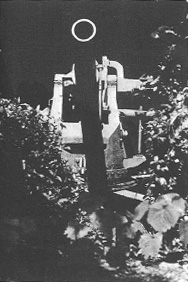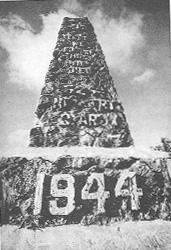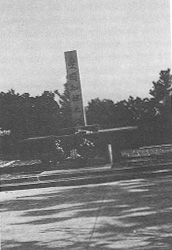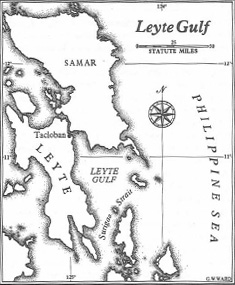Goodbye, Darkness (46 page)

A Japanese gun, mysteriously oiled and ready for action
Now I decide to ascend the ridge. My young companions are dismayed. At my age, they argue, the climb is folly, and I know they are right, but I have to do what I have to do. If the decision is irrational, so was my enlistment in the Marine Corps and all that followed. The girl and Loitang stay below, preparing our lunch. Dave ascends first, pulling me up over the huge stones, deep clefts, steep pinnacles, and beetling outcroppings while the magistrate propels me upward. I reach the crest filthy and bleeding from scratches. There I find the only American monument on Peleliu, or, to be more exact, what is left of the monument. It is a granite column with a white limestone inscription which reads:
LEST
WE
FO ET
THOSE
WH
DIED
32
NF TRY
S. AR Y
1944
Exhausted as I am, I feel a surge of fury. To commit brave men to a needless struggle was criminal; to consign them to oblivion is profane. Is this the apotheosis of our mourning? Can we
fo et
them so completely? Are the Japanese prouder of their men than we? Can't the Pentagon spare a few token dollars out of its billions for a decent memorial? Can't the American Legion and the VFW, so adept at lobbying for live veterans, pause to propose a suitable tribute to those who, though they cannot vote, safeguarded our right to do so? Back on the beach I nibble bleakly on a sandwich, poking at driftwood and clots of seaweed with my field boot. There are times when one understands the pull of primitive superstition. A recent article in the
Marine Corps Gazette
complained that the “American news media … contributed to the almost total neglect of this historic battle by focusing the American public's attention on events in Europe and in the Philippines as Peleliu dragged out its bloody course.” The press is, of course, everyone's scapegoat. The fact is that the liberation of France, the Lowlands, and the Philippines was more fascinating, and also more successful, than this pointless hammering of American flesh on a distant anvil of despair. No, Peleliu — like Arnhem, which was being fought simultaneously on the other side of the world — appears to have been doomed from the very outset. It almost seems as though both were hexed.

The American monument at Peleliu

A typical Japanese monument
On the map the island of Leyte, MacArthur's first Philippine target, resembles a molar tooth, its roots pointing downward. To the south lies Mindanao, as big as Ireland; to the north, Luzon, nearly as large as England. In the predawn hours of Friday, October 20, when fighting was still heavy around Peleliu's airstrip, MacArthur stood aboard the cruiser
Nashville,
waiting for the first waves of his 200,000 veteran GIs to leap ashore on Leyte's east coast, the last place the Japanese expected him. The vain, brilliant general had perfected a battle plan which he considered his best yet. After the war Vincent Sheean agreed: “His operations towards the end … were extremely daring, more daring and far more complicated than those of Patton in Europe, because MacArthur used not infantry alone but also air and seapower in a concerted series of jabbing and jumping motions designed to outflank and bypass the Japanese all through the islands.” When all else is said about this baffling, exasperating man, the fact remains that in all his campaigns he was remarkably economical of human life; his total casualties from Australia to V-J Day (90,437) were fewer than the ETO's in the single Battle of the Bulge (106,502).
At daybreak the U.S. warships opened fire on the beach. The general watched from the
Nashville's
bridge. The shore was dimly visible through a rising haze shot with yellow flashes; inland, white phosphorus crumps were bursting among the thick, ripe underbrush of the hills. As the first waves of American infantry hit Red Beach, MacArthur descended a ship's ladder to a barge. Fifty yards from shore they ran aground. That was unexpected. The general had counted on tying up at a pier and stepping majestically ashore, immaculate and dry. Most of the docks had been destroyed in the naval bombardment, however, and while a few were still intact, the naval officer serving as beachmaster — whom no one, not even MacArthur, could overrule — had no time to show the general's party where they were. When he growled, “Let 'em walk,” they had no choice. MacArthur, greatly annoyed, ordered the barge ramp lowered, stepped off into knee-deep brine, and splashed forty wet strides to the shore, eliminating the neat creases of his trousers. A newspaper photographer snapped the famous picture of this.
MacArthur's scowl, which millions of readers interpreted as a reflection of his steely determination, was actually a wrathful glare at the impertinent naval officer. When the general saw a print of the photograph, however, he instantly grasped its dramatic value, and the next day he deliberately waded ashore for cameramen on a safe beach which had been secured by troopers of the First Cavalry Division. Later the First Cavalry's troopers, seeing the photograph taken the day before, condemned it as a phony. Another touch had been added to MacArthur's antihero legend.

Standing in a rainstorm, holding a hand microphone, he broadcast to Filipinos: “People of the Philippines, I have returned. … Rally to me. … As the lines of battle roll forward to bring you within the zone of operations, rise and strike. Strike at every favorable opportunity. For your homes and hearths, strike! For future generations of your sons and daughters, strike! In the name of your sacred dead, strike!”
Now that the general had committed himself to Leyte, now that his men were pouring ashore, the Japanese navy and air force made their last great move of the war. Their commanders still cherished the hope of changing the fortunes of war at sea, preferably while our warships were covering a landing. This was the hour. Four separate Jap forces sailed against Halsey's powerful main fleet, which was protecting the operation, and Thomas Kinkaid's weaker group of old battleships and small carriers. The enemy admirals knew they could no longer match our power, so they hatched a brilliant plan. Leyte Gulf, where MacArthur was, could be reached through two straits, San Bernardino to the north and Surigao to the south. The Japanese center force was to head for San Bernardino while two southern forces steamed into Surigao. At the same time, a fourth force, acting as a decoy, was to lure Halsey away to the north. Kinkaid would be helpless.
Banzai.
Salvo by salvo the two huge fleets roared away at one another over an area as large as France. Nippon's southern prongs had no luck. Torpedoes and gunfire wiped out the first of them; the second turned back after firing at radar pictures which were really islands. In the beginning the center force also seemed luckless. American submarines destroyed two of its cruisers; its largest battleship was sunk by planes. Actually these losses were a break for the enemy. Halsey, learning of them and assuming that the rest of that force was retiring, took out after the fourth force — the bait — leaving San Bernardino Strait unguarded. In the darkness the Japs slipped through unobserved. But the Nips milled around, confused by intercepted American messages, and turned back as U.S. destroyers made smoke. American warplanes flew in pursuit of the retreating enemy and Halsey returned at flank speed. Thus ended the Battle of Leyte Gulf. It had involved 282 warships, compared with 129 in the Spanish Armada and 250 at Jutland, until then the greatest naval engagement in history. And unlike Jutland, which neither side won, this action had been decisive. After the last distant broadside had been fired the Americans had lost one light carrier, two escort carriers, and three destroyers. They had sunk four carriers, three battleships, six heavy cruisers, three light cruisers, and eight destroyers. Except for sacrificial kamikaze fliers, who made their debut in this battle, Japanese air squadrons and naval strength would never again be serious instruments in the war.
MacArthur would tolerate no criticism of Halsey in his mess. He slammed his bunched fist on the table and roared, “Leave the Bull alone! He's still a fighting admiral in my book.” Halsey had been loyal to him in earlier struggles, and he was reciprocating. Though both men were prima donnas, they remained on the best of terms, perhaps because each recognized himself in the other. Among other things, the admiral admired the general's courage. On Leyte MacArthur had chosen as his CP a two-story stucco-and-concrete mansion, previously owned by an American businessman named Walter Price, at the corner of Santo Niño and Justice Romualdez streets in the town of Tacloban. The home was the most spacious in the community — the Japanese had used it as an officers' club — and therefore a prime target. As he was striding back and forth on the wide veranda, MacArthur suddenly halted and pointed at the yard, saying, “What's that mound of earth there by the edge of the porch?” One of his men explained that it was an elaborate bomb shelter built by the Japanese. The general said, “Level it off and fill the thing in. It spoils the looks of the lawn.” Though Radio Tokyo broadcast that they knew the general had established his “headquarters in the Price house, right in the center of town,” and though Zeroes and Mitsubishis attacked Tacloban daily, often missing MacArthur by a few feet or less, he refused to move. This is the man we called “Dugout Doug.”
His greatest problem was the wet weather, which erased the margin that superior air power should have given him. He had called Leyte a springboard, but it was proving to be a very soggy one. In forty days, thirty-four inches of rain fell, turning the island into one vast bog. Runway grading was impossible. GIs captured five airfields, but the island's drainage system was such that they had become useless mud flats. To top that, Leyte was struck by an earthquake and three typhoons during the fighting. The Japanese, with firm fields on surrounding islands, swooped in low over the hills, permitting their land commanders to reinforce Leyte easily. Yet the doubts of Tomoyuki Yamashita, the enemy commander, were growing daily. He knew that Leyte was a lost cause, that eventually the weather would improve. MacArthur extended his flanks in the first week of November, and by Thanksgiving he had the enemy garrison trapped. Fighting continued until Saint Patrick's Day, 1945, but long before then the general was plotting his invasion of Luzon and the recapture of Manila. For Dai Nippon, Leyte had been a catastrophe. Apart from the destruction of their planes and the backbone of their fleet, the Nips had lost sixty-five thousand front-line troops. Their supply lines to the Dutch East Indies, vital for raw materials they needed to survive, had been pierced. Even Hirohito despaired.